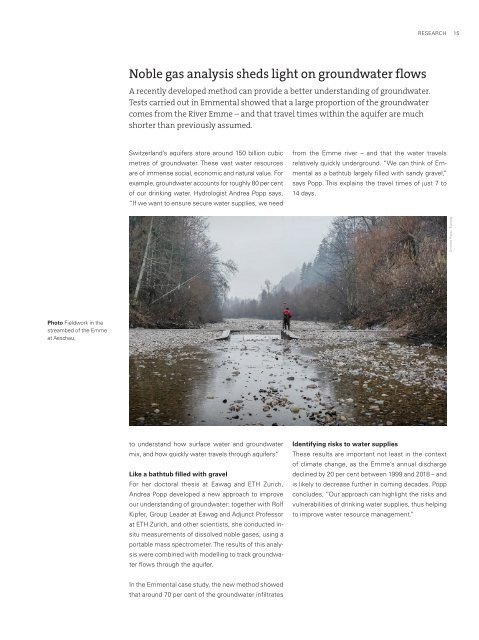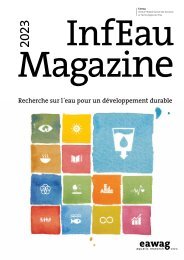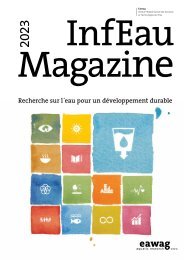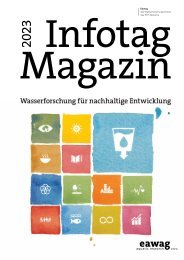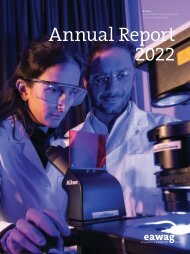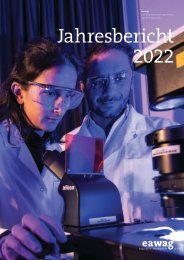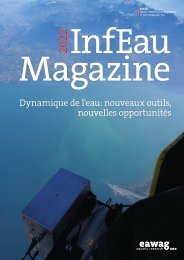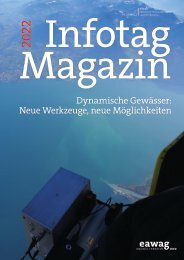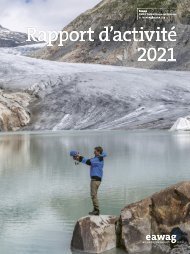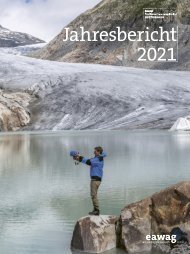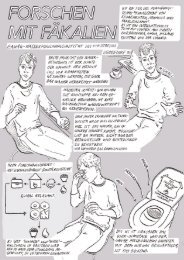Eawag Annual Report 2021
The Annual Report gives a wide-ranging account of current Eawag projects. It is published in English and German, and since 2013 also in French.
The Annual Report gives a wide-ranging account of current Eawag projects. It is published in English and German, and since 2013 also in French.
You also want an ePaper? Increase the reach of your titles
YUMPU automatically turns print PDFs into web optimized ePapers that Google loves.
RESEARCH<br />
15<br />
Noble gas analysis sheds light on groundwater flows<br />
A recently developed method can provide a better understanding of groundwater.<br />
Tests carried out in Emmental showed that a large proportion of the groundwater<br />
comes from the River Emme – and that travel times within the aquifer are much<br />
shorter than previously assumed.<br />
Switzerland’s aquifers store around 150 billion cubic<br />
metres of groundwater. These vast water resources<br />
are of immense social, economic and natural value. For<br />
example, groundwater accounts for roughly 80 per cent<br />
of our drinking water. Hydrologist Andrea Popp says,<br />
“If we want to ensure secure water supplies, we need<br />
from the Emme river – and that the water travels<br />
relatively quickly underground. “We can think of Emmental<br />
as a bathtub largely filled with sandy gravel,”<br />
says Popp. This explains the travel times of just 7 to<br />
14 days.<br />
Andrea Popp, <strong>Eawag</strong><br />
Photo Fieldwork in the<br />
streambed of the Emme<br />
at Aeschau.<br />
to understand how surface water and groundwater<br />
mix, and how quickly water travels through aquifers.”<br />
Like a bathtub filled with gravel<br />
For her doctoral thesis at <strong>Eawag</strong> and ETH Zurich,<br />
Andrea Popp developed a new approach to improve<br />
our understanding of groundwater: together with Rolf<br />
Kipfer, Group Leader at <strong>Eawag</strong> and Adjunct Professor<br />
at ETH Zurich, and other scientists, she conducted insitu<br />
measurements of dissolved noble gases, using a<br />
portable mass spectrometer. The results of this analysis<br />
were combined with modelling to track groundwater<br />
flows through the aquifer.<br />
Identifying risks to water supplies<br />
These results are important not least in the context<br />
of climate change, as the Emme’s annual discharge<br />
declined by 20 per cent between 1999 and 2018 – and<br />
is likely to decrease further in coming decades. Popp<br />
concludes, “Our approach can highlight the risks and<br />
vulnerabilities of drinking water supplies, thus helping<br />
to improve water resource management.”<br />
In the Emmental case study, the new method showed<br />
that around 70 per cent of the groundwater infiltrates


